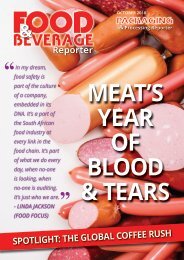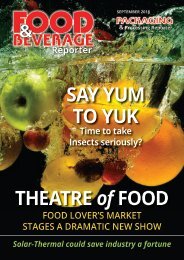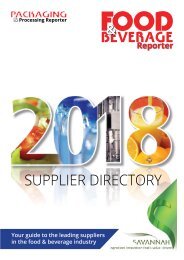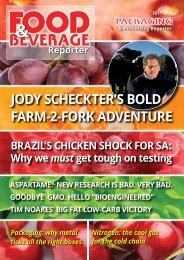Food & Beverage Reporter August 2018
South Africa's leading B2B magazine for the food & beverage sector and its allied industries in processing/packaging etc
South Africa's leading B2B magazine for the food & beverage sector and its allied industries in processing/packaging etc
Create successful ePaper yourself
Turn your PDF publications into a flip-book with our unique Google optimized e-Paper software.
THOUGHT FOR FOOD<br />
of the food. This has been an ongoing<br />
problem since time immemorial with<br />
early solutions like smoke or salt curing,<br />
fermentation and other solutions in<br />
common use since antiquity.<br />
Many of these were used well<br />
into the 19th Century and beyond<br />
until reliable alternatives were devised<br />
by visionaries like Louis Pasteur and<br />
Lloyd Hall.<br />
New techniques currently in<br />
development include High-Pressure<br />
Processing (HPP). This is a conservation<br />
technique that could quadruple or even<br />
extend by 10 times the shelf life<br />
of food products in the not too<br />
distant future.<br />
HiPP is a cold<br />
pasteurization process<br />
that introduces foods<br />
sealed in packaging into<br />
a high isostatic pressure<br />
environment (300-600<br />
MPa) that is transmitted<br />
by water. That is more<br />
pressure that can be<br />
found at the base of the<br />
Mariana Trench.<br />
This technique<br />
effectively inactivates<br />
micro-organisms to<br />
guarantee food safety.<br />
This combination of high<br />
pressure and<br />
low-temperature<br />
environment safely<br />
maintains the taste,food,<br />
appearance, texture and<br />
nutritional value of food.<br />
HPP respects the sensorial and<br />
nutritional properties of food because<br />
it does not use heat, and maintains<br />
its original freshness throughout its<br />
shelf-life. Another benefit of HPP is<br />
the fact that no irradiation or chemical<br />
preservatives need to be introduced in<br />
the process.<br />
3D printing of food<br />
3. Automated grading systems<br />
Companies like Aris have started to<br />
deliver innovative food production<br />
using something called an AQS-system.<br />
This system is used to grade and sort<br />
chickens (and potentially other animals)<br />
efficiently and accurately. AQS lets clients<br />
sort chickens by their shape, size, color<br />
and any other characteristics desired.<br />
This relatively new system can<br />
manage in excess of 1 000 chickens in<br />
one hour, greatly improving food<br />
production efficiency.<br />
Aris's AQS-system is, by all accounts,<br />
the first of its kind. It uses a camera<br />
system and software programme to<br />
detect a suite of variations (like colour)<br />
on the examined specimen. This system<br />
registers many profile deviations like<br />
broken wings or missing parts, poor<br />
colouration etc, and can even learn and<br />
improve itself over time.<br />
The AQS-system also collects<br />
data from the products and product<br />
streams to feed and control the entire<br />
slaughterhouse operating system.<br />
Aris have also devised similar systems<br />
for grading plants like orchids, potplants,<br />
and other seedlings at impressive rates<br />
per hour. This kind of automation could<br />
completely replace humans as they<br />
provide a greater level of accuracy and<br />
can operate tirelessly without needing to<br />
take breaks or holidays.<br />
4. Insect proteins<br />
Although eating insects is par for the<br />
course for many nations, there is now<br />
intensive global interest in developing<br />
insect proteins to feed a fast-growing<br />
global population. Insect protein tends to<br />
contain about 60% protein, is high with<br />
vitamin B12, has more calcium than milk.<br />
It also has more iron than spinach and<br />
can supply all the essential amino acids<br />
Insect “meat” is also better for the<br />
environment compared to its lumbering<br />
four-legged alternatives. It requires<br />
much less water and requires much<br />
less physical space. If insect protein<br />
popularity grows, it could spark an<br />
entirely new industry and create<br />
hundreds, if not thousands, of jobs.<br />
5. Robot chefs<br />
Restaurants and celebrity chefs might<br />
become a thing of the past if companies<br />
like Moley have anything to say about it.<br />
They have been busy developing one<br />
of the world's first automated<br />
kitchens -<br />
a so-called robochef.<br />
It consists of a pair of fullyarticulated<br />
and automated<br />
robotic arms that can, for all<br />
intent and purpose, replicate the<br />
movement of human arms and<br />
hands.<br />
Moley believes that their<br />
robotic chef has the same level<br />
of dexterity as that of any<br />
human alternative - especially<br />
when it comes to speed<br />
and sensitivity.<br />
This robot chef takes its<br />
cue from famous chefs whose<br />
cooking skills are being followed<br />
to the letter by the robot. Each<br />
recorded “recipe” is not only a list<br />
of ingredients and a set of instructions<br />
but also a complete and accurate replay<br />
of the original chef's actual movements.<br />
In the long run, the company plans to<br />
produce a self-contained “kitchen” that<br />
is operated by touch screen or smart<br />
app. It will, in effect, be like a takeaway<br />
restaurant but at home - you could even<br />
order dinner on your way home from<br />
work and have it ready by the time<br />
you arrive.<br />
6. Lab-grown meat<br />
Lab-grown meat, otherwise known as in<br />
vitro animals or “clean meat”, could be<br />
on sale very soon indeed. It could also<br />
make meat production a new form of<br />
sustainable engineering.<br />
This kind of “meat” is grown<br />
from stem<br />
To Next Page<br />
www.fbreporter.co.za FOOD & BEVERAGE REPORTER | AUGUST <strong>2018</strong> 7







